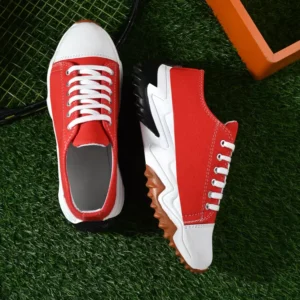Running Shoes For Men
₹159.00
Key Features
| Characteristic | Description |
|---|---|
| Color | Blue |
| Outer material | Canvas |
| Model name | Top Rated, Best Rates Training Shoes, Walking Shoes, Gym Shoes, Sports Shoes, Running Shoes For Men, Cricket Shoes, Hockey Shoes, Volleyball Shoes, Hiking Shoes, Casual Shoes, Lightweight, Football Shoes, Badminton Shoes, Basketball Shoes, Gym Shoes, Trekking Shoes, Waterproof Shoes, Juta, Tennis Shoe |
| Ideal for | Men |
| Occasion | Sports |
| Type For Sports | Running Shoes |
| Sole material | PVC |
| Closure | Lace-Ups |
| Upper Pattern | Printed |
- Purpose and Functionality: Running shoes are designed primarily for running or jogging. They are engineered to provide the necessary cushioning, support, and shock absorption required to minimize the impact of each stride and reduce the risk of injury during running activities.
- Comfort: Comfort is a key aspect of running shoes. They often feature cushioned insoles, padded collars, and breathable materials to ensure a comfortable fit throughout a run. This comfort is crucial for long-distance runners.
- Design and Construction: Running shoes come in various designs to cater to different running styles and preferences. Common designs include neutral running shoes for those with a natural gait, stability running shoes for overpronators, and motion control running shoes for severe overpronation.
- Outer Material: Running shoes can be made from a variety of materials, including mesh, synthetic materials, and knit fabrics. These materials are chosen for their breathability, durability, and weight-saving properties.
- Sole Material: The sole material is a critical component of running shoes. Many running shoes feature specialized midsoles made from materials or proprietary cushioning technologies such as Nike’s Air or Adidas’ Boost. These midsoles provide cushioning and support for the foot during each stride.
- Tread Pattern: The tread pattern on the outsole of running shoes is designed to provide traction and grip on various surfaces. The pattern can vary depending on whether the shoes are intended for road running, trail running, or a combination of both.
- Fit and Sizing: Running shoes should fit snugly but not too tightly. Many brands offer various sizing options, including different widths, to accommodate different foot shapes. A proper fit is crucial to prevent blisters and discomfort during runs.
- Weight: Running shoes are typically lightweight to minimize the energy expenditure required during running. Lighter shoes can help runners maintain their pace and reduce fatigue.
- Brand and Model: There are numerous brands and models of running shoes available on the market, each with its own unique features and technologies. Runners often choose shoes based on their individual preferences and needs.
- Price Range: The price of running shoes can vary significantly, ranging from budget-friendly options to high-end, premium models. The price often reflects the materials used, technology incorporated, and brand reputation.
- Maintenance: Proper maintenance, such as cleaning and occasional replacement of insoles or outsoles, can prolong the lifespan of running shoes and maintain their performance.
| Size | 7, 8, 9, 10, 11, 12 |
|---|---|
| Color | Blue, White |
Be the first to review “Running Shoes For Men” Cancel reply
Related products
Casual Shoes
₹199.00
₹149.00
Casual Shoes
₹199.00
₹99.00
₹249.00
₹189.00








Reviews
There are no reviews yet.